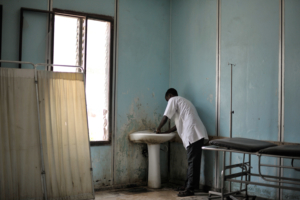10 Facts About Sanitation in Sierra Leone
 Sierra Leone is a country on the west coast of Africa with a population of more than 7.5 million people and is perhaps most widely known for its turbulent diamond trade. The country’s heart resides in its lively capital, Freetown and it attracts many visitors with its beautiful beaches and vibrant rainforests. Despite its rich natural resources, the country struggles when it comes to providing adequate sanitation services for its citizens. Here are 10 facts about sanitation in Sierra Leone.
Sierra Leone is a country on the west coast of Africa with a population of more than 7.5 million people and is perhaps most widely known for its turbulent diamond trade. The country’s heart resides in its lively capital, Freetown and it attracts many visitors with its beautiful beaches and vibrant rainforests. Despite its rich natural resources, the country struggles when it comes to providing adequate sanitation services for its citizens. Here are 10 facts about sanitation in Sierra Leone.
10 Facts About Sanitation in Sierra Leone
- A decade-long civil war severely impacted the country’s infrastructure. Ensuring access to safe water and sanitation services has been a top priority during Sierra Leone’s post-conflict governance reform. However, there is still much work to be done to restore services that halted during the war in the 1990s.
- Waste management is a major challenge. The Minister of the State, Office of the Vice President, Mohamed Alie Bah said in 2017 that the increasing amounts of solid waste need to be addressed, as the problem will only worsen with expected population growth. The Ministry of Health and Sanitation in Sierra Leone is troubleshooting the most effective and sustainable ways to address the problem with the hopes of improving overall health and wellness in their communities.
- Nearly 3 million people lack access to clean water. As a result, millions drink from freestanding water such as ponds and unprotected wells, which increases the likeliness of exposure to infections and parasites. According to a 2017 report, risks associated with poor water, sanitation and health facilities are the second largest cause of death and disability. The Water Project is an example of one nonprofit working to improve clean water access in Sierra Leone. To date, the group has built wells that have benefited 7,000 Sierra Leoneans to date.
- Diarrheal disease is a leading cause of child death. Drinking unclean water that contains bacteria or parasites can lead to an infection in the intestinal tract. Diarrheal disease usually results in malnutrition and dehydration, which can become fatal. In Sierra Leone, more than 1,400 children die from diarrheal diseases each year.
- Sierra Leone is trying to improve water quality and availability. Officials in Sierra Leone are aware of the importance of providing adequate drinking water and are currently taking steps to conceptualize, budget and fundraise for systems that would hopefully improve the country’s water supply. Due to a lack of funding, it appears that the project will be a collaborative effort between several sectors and organizations. An anticipated $164 million annual investment is needed to create and maintain rural and urban water supply facilities. Even with donations from organizations such as the World Bank and UNICEF, the monetary goal is expected to be missed by a large margin, around $130 million.
- Sierra Leone has one of the world’s highest maternal mortality rates. While a majority of maternal deaths are caused by severe bleeding, 11 percent of the deaths are caused by sepsis. Most maternal deaths are treatable and preventable, and this statistic is another indicator of the changes that still need to be made. Over recent years, the Ministry of Health and Sanitation in Sierra Leone has partnered with the World Health Organization to implement several health initiatives, including the Emergency Obstetric and Newborn Care training program, which aims to ensure health care professionals have the knowledge needed to manage child-birth related complications.
- Hand-washing facilities are often lacking. According to a report published by the Government of Sierra Leone in 2017, 27 percent of people in urban areas have access to hand-washing facilities with soap and water, and only 15 percent of people in rural communities have the same access.
- Household toilet facilities are often inadequate. Nationally, only 16 percent of households have an improved toilet facility, which is defined as “a non-shared facility constructed to prevent contact with human waste.” These facilities reduce the spread of diseases such as cholera and typhoid. Conversely, 18 percent of households nationwide do not have access to any toilet facilities, and instead, must defecate outdoors.
- Poor menstruation hygiene management affects girls’ education in Sierra Leone. Girls in Sierra Leone can face several challenges while menstruating, especially while attending school. The quality of restroom facilities can vary at schools, but oftentimes there are not bathrooms with running water or separate facilities for girls. This leads to girls having difficulty disposing of pads and managing their periods, which can leave them feeling embarrassed or distracted during classes. Others miss school altogether during their periods.
- Training is being offered to prepare Sierra Leone for future disasters or outbreaks. The CDC offers water, sanitation and hygiene (WASH) training to help at-risk countries strengthen their infrastructure and workforce to ensure they are prepared to prevent, detect and respond to infectious disease threats. There are several facets to the training, such as Outbreak Investigation Training, which trains public health staff to detect and respond to waterborne diseases, and training to teach students how to test water samples for contamination.
Improving sanitation in Sierra Leone has been a priority for the nations’ leaders for decades. While finances continue to be a challenge, improvements have been made thanks to the efforts of organizations within the country, such as the Ministry of Health and Sanitation, as well as organizations outside of the country, such as the World Health Organization.
– Lindsey Shinkle
Photo: Flickr
